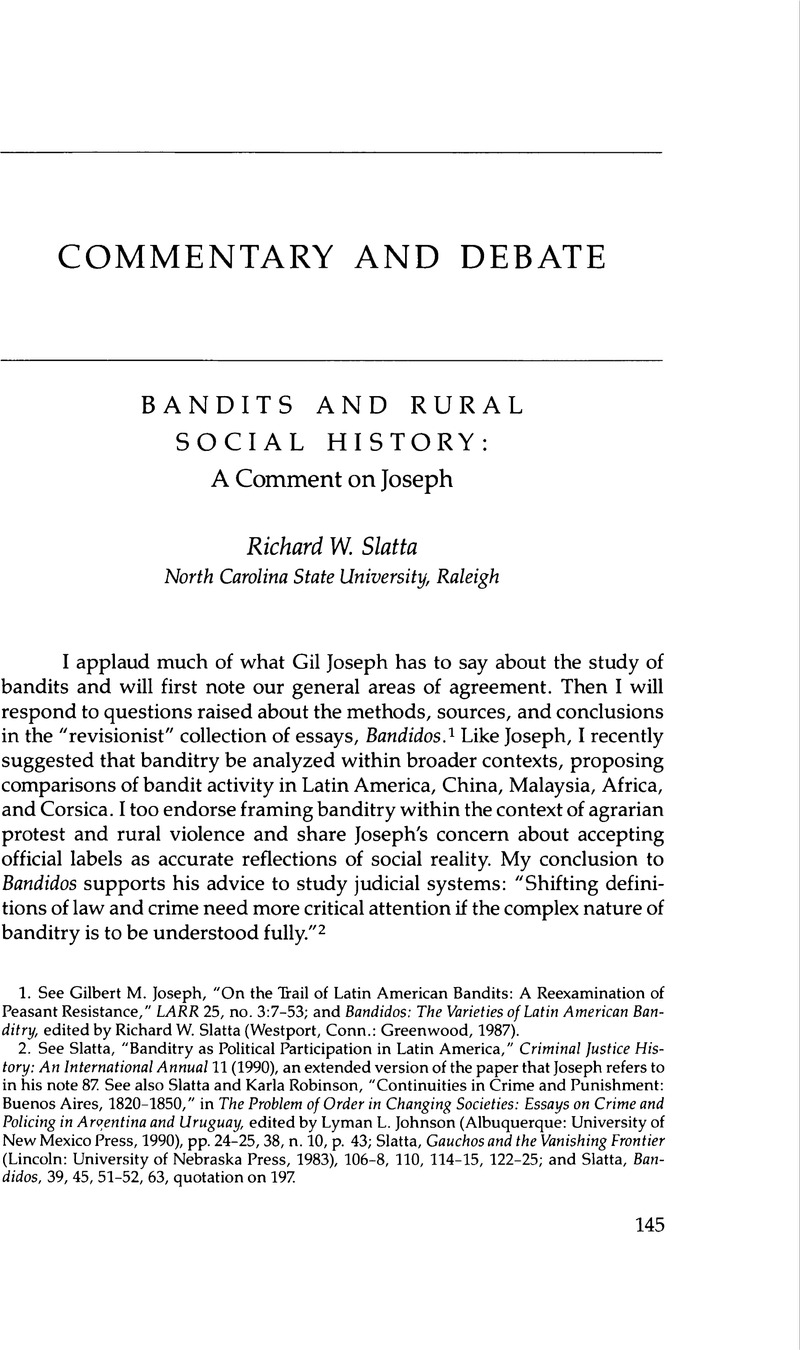Article contents
Bandits and Rural Social History: A Comment on Joseph
Published online by Cambridge University Press: 12 October 2022
Abstract

- Type
- Commentary and Debate
- Information
- Copyright
- Copyright © 1991 by the University of Texas Press
References
Notes
1. See Gilbert M. Joseph, “On the Trail of Latin American Bandits: A Reexamination of Peasant Resistance,” LAR 25, no. 3:7–53; and Bandidos: The Varieties of Latin American Banditry, edited by Richard W. Slatta (Westport, Conn.: Greenwood, 1987).
2. See Slatta, “Banditry as Political Participation in Latin America,” Criminal Justice History: An International Annual 11 (1990), an extended version of the paper that Joseph refers to in his note 87. See also Slatta and Karla Robinson, “Continuities in Crime and Punishment: Buenos Aires, 1820–1850,” in The Problem of Order in Changing Societies: Essays on Crime and Policing in Argentina and Uruguay, edited by Lyman L. Johnson (Albuquerque: University of New Mexico Press, 1990), pp. 24–25, 38, n. 10, p. 43; Slatta, Gauchos and the Vanishing Frontier (Lincoln: University of Nebraska Press, 1983), 106–8, 110, 114–15, 122–25; and Slatta, Bandidos, 39, 45, 51–52, 63, quotation on 197.
3. Erick Langer, “Andean Banditry and Peasant Community Organization,” in Slatta, Bandidos, 124.
4. They “Knew” Billy the Kid: Interviews with Old-Time New Mexicans, edited by Robert F. Kadlec (Santa Fe, N.M.: Ancient City Press, 1987), especially the “Afterword” by Jeff Dykes, 109–11; Stephen Tatum, Inventing Billy the Kid: Visions of the Outlaw in America, 1881–1981 (Albuquerque: University of New Mexico Press, 1982), 5–8, 168; Robert Utley, Billy the Kid, A Short and Violent Life (Lincoln: University of Nebraska Press, 1989).
5. See Billy Jaynes Chandler, King of the Mountain: The Life and Death of Giuliano the Bandit (DeKalb: Northern Illinois University Press, 1988); Banditry, Rebellion, and Social Protest in Africa, edited by Donald Crummey (Portsmouth, N.H.: Heinemann, 1986); Phil Billingsley, Bandits in Republican China (Stanford, Calif.: Stanford University Press, 1988); Stephen Wilson, Feuding, Conflict, and Banditry in Nineteenth-Century Corsica (Cambridge: Cambridge University Press, 1988); Giannes Koliopoulos, Brigands with a Cause: Brigandage and Irredentism in Modern Greece, 1821–1912 (Oxford: Clarendon Press, 1987); and Boon Kheng Cheah, The Peasant Robbers of Kedah, 1900–1929: Historical and Folk Perceptions (New York: Oxford University Press, 1988).
6. Eric Hobsbawm, Bandits, rev. ed. (New York: Pantheon, 1981), 17–18; and Hobsbawm, “Social Banditry,” in Rural Protest: Peasant Movement and Social Change, edited by Henry A. Landsberger (London: Macmillan, 1974), 143.
7. William B. Taylor, “Banditry and Insurrection: Rural Unrest in Central Jalisco, 1790–1816,” in Riot, Rebellion, and Revolution: Rural Social Conflict in Mexico, edited by Friedrich Katz (Princeton, N.J.: Princeton University Press, 1988), 211. Searches around the globe have turned up few flesh-and-blood bandits who have enjoyed the popular support found in legend and fiction. See Slatta, “Banditry as Political Participation,” and the sources cited in note 5.
8. Florencia Mallon, “Nationalists and Antistate Coalitions in the War of the Pacific: Junín and Cajamarca, 1879–1902,” in Resistance, Rebellion, and Consciousness in the Andean Peasant World, 18th to 20th Centuries, edited by Steve J. Stern (Madison: University of Wisconsin Press, 1987), 255; Lewis Taylor, Bandits and Politics in Peru: Landlord and Peasant Violence in Hualgayoc, 1900–30 (Cambridge: Centre of Latin American Studies, Cambridge University, n.d.), 3, 113–14; and Slatta, review of Taylor, Bandits and Politics, in Hispanic American Historical Review 68, no. 1 (Feb. 1988):172–74.
9. Knight, The Mexican Revolution, 2 vols. (Cambridge: Cambridge University Press, 1986), 1:122–25, 352; 2:393–95.
10. Hobsbawm, Bandits, 70–82; Ralph A. Austen, “Social Bandits and Other Heroic Criminals: Western Models of Resistance and Their Relevance for Africa,” in Crummey, Banditry, Rebellion, and Social Protest in Africa, 86–107.
11. Hobsbawm, Bandits, 72, 76–79.
12. Knight, Mexican Revolution, 2:393–95; Sánchez and Meertens, “Political Banditry,” in Slatta, Bandidos, 164–68; Hobsbawm, prologue to Sánchez and Meertens, Bandoleros, gamonales y campesinos: el caso de la Violencia en Colombia (Bogotá: Ancora, 1983), 10; and L. Taylor, Bandits and Politics in Peru, 113–14.
13. Rosalie Schwartz, Lawless Liberators: Political Banditry and Cuban Independence (Durham, N.C.: Duke University Press, 1989), 3, 9–11, 52, 64–65; Hobsbawm, Bandits, 110; and Louis A. Pérez, Jr., Lords of the Mountain: Social Banditry and Peasant Protest in Cuba, 1878–1918 (Pittsburgh: University of Pittsburgh Press, 1989), 114.
14. Hobsbawm, Bandits, 58.
15. See Erick D. Langer, Economic Change and Rural Resistance in Southern Bolivia, 1880–1930 (Stanford, Calif.: Stanford University Press, 1989); and Knight, Mexican Revolution.
16. Donald Black, Sociological Justice (New York: Oxford University Press, 1989), 8; Black, The Behavior of Law (New York: Academic Press, 1976), 3–4, 12; James C. Scott, Weapons of the Weak: Everyday Forms of Peasant Resistance (New Haven: Yale University Press, 1985).
17. Robert W. Fogel and Stanley L. Engerman, Time on the Cross: The Economics of American Negro Slavery, 2 vols. (Boston: Little, Brown, 1974).
18. Mark Poster, Critical Theory and Poststructuralism: In Search of a Context (Ithaca, N.Y.: Cornell University Press, 1989), 27.
19. For discussions of Foucault, see Hubert L. Dreyfus and Paul Rabinow, Michel Foucault: Beyond Structuralism and Hermeneutics, 2d ed. (Chicago: University of Chicago Press, 1983), 120–25; Poster, Critical Theory; and Foucault: A Critical Reader, edited by David Couzens Hoy (London: Basil Blackwell, 1986). Similar problems face historians taking up Gramscian hegemony. The term suffers confusing “slippage” at the hands of the master and his disciples. See Hoy, Foucault, 159.
20. Katz, ed., Riot, Rebellion, and Revolution; Stern, ed., Resistance, Rebellion, and Consciousness in the Andean Peasant World; and Crummey, ed., Banditry, Rebellion, and Social Protest in Africa.
- 6
- Cited by


